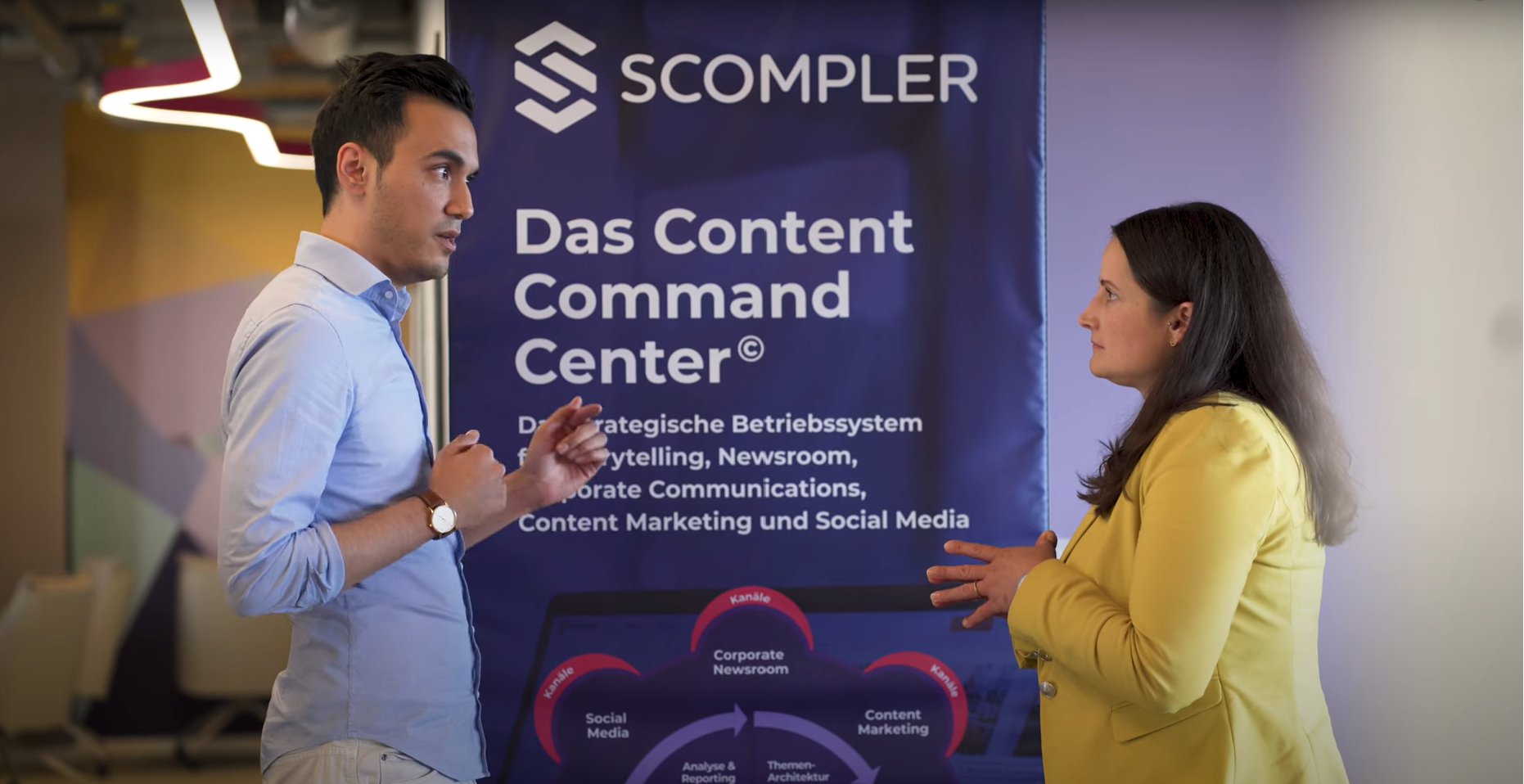
For five years now, we have been working almost exclusively on the question of how to best anchor content marketing in the company. Not just as another isolated marketing technique alongside SEO, social media, e-mailings, press relations, corporate publishing, etc., but as a management discipline with the aim of understanding "content" as a real asset and managing it across disciplines. The path is not easy, but the effect is enormous: this is how companies make themselves fit for the future.
Behind us are around 100 strategy mandates and the training of a total of around 500 marketing specialists from companies as part of seminars lasting several days, for example at 121Watt or the Swiss School of Journalism. They have all given us a deep and varied insight into the structures and working methods of companies. The twelve insider tips presented here are an extract from this experience. They should be very valuable for anyone who wants to put their content marketing on a new, strategic footing. Every single point implemented makes content marketing better, i.e. "better" in the sense of "coordinated", "more targeted", "more repeatable", "more efficient" or "more prominent".
Note: For practical support, I have linked various presentations and checklists, all of which are available for download as open files.
12 success factors for strategic content marketing:
- Value contribution: Understand what content can specifically contribute to the success of your organization!
- Leadership: Define goals in such a way that they provide concrete orientation for decisions!
- Needs: Concentrate only on the needs that are relevant to you!
- Topic plan: Develop a clear, stringent structure for your content!
- Storyboarding: Develop concrete stories from each topic that reflect the reality of your personas' lives!
- Substance: Be clear about how important "substance" is for your content.
- Formats: Tell your stories using variations and adaptations where possible!
- Editorial plan: Plan the content in an editorial plan and create a central content database.
- Coordination: Improve coordination with other disciplines.
- Distribution: Understand that there is a direct link between "reach" and substance, formats and staging.
- Control: Create transparency about what you do exactly and how, and control content production.
- Content brand: Make sure that people have a concrete idea of how they can benefit from your content when they see it.
Understand what content can specifically contribute to the success of your organization!
What I have found to be most important in all projects is that you understand your company's business model. It sounds banal, but it's always worth considering. You need this to determine what contribution "content" can make to the success of your company. This is the "why" of your content marketing, and it forms the basis for our "core story".
On the one hand, these can be "leads" that are caught with the "bait of content", so to speak. This is relatively simple - both in terms of thinking and implementation. And it is quite superficial. However, it will be far more important and effective to understand why customers should buy from you or why they should believe you - and not the competition: Because you are the most competent? Or the most service-oriented? Because they trust you more than others? Or because you are simply the most likeable? Even if you have the lead, you still have to fulfill the customer's specific need in order for them to buy.
There are many reasons that can be extremely important, perhaps even essential, to the target groups and to which "content" can make a very significant contribution. Only if customers want "the cheapest" will you have a hard time with content. Then you can still use it for "attention", but the true strengths of content are then lost. And there is still the risk that customers will take the content but then buy from the cheaper competitor. Everything is transparent online.
Define goals in such a way that they represent a concrete call to action!
Two things have emerged in the definition of objectives: Firstly, I recommend categorizing goals into commercial, strategic and tactical goals. This simply brings more structure to the objectives and makes it much easier to work with the KPIs.
The different objectives are as follows:
- Commercial goals are goals that can be directly translated into business figures, i.e. "money". In particular, these are new customers, customer loyalty and up- or cross-sell. The only problem here is that the direct link between content and success is usually difficult to prove. However, these goals also include "leads", both in terms of quantity and quality. This is because they often come directly from the content measure and can also be followed up. However, working with leads requires that there is some form of "lead management" in the company, i.e. that the handover to sales works and that they then process these leads further.
- Strategic goals are the goals that we discussed above with regard to the value contribution of content, e.g. competence leadership or service leadership. I believe it is absolutely essential to work on these areas, as they have a major influence on whether sales are successful. It is as if we are fertilizing the soil with this content, which the sales department then cultivates and harvests. This can often only be measured through market research.
- Tactical goals are anything that can help you achieve the first two goals, such as attention, traffic, engagement, etc.. However, they are only ever a means to an end. They are the easiest to measure, but they are also the furthest away from the actual value creation.
- Operational goals relate to what you do in your day-to-day work. For example, the amount of content you produce per channel, the ratio between content formats, quality standards, etc., etc. They are extremely important because they determine everything that comes afterwards. If you don't have your content operations under control, success is a matter of chance.
- Individual goals are the goals and personal needs of your stakeholders. Ideally, they correspond with the goals from above, but you would do well to pay attention to how these stakeholders perceive these goals - and how you formulate them. Because you need the stakeholders and they should know that content marketing also supports them personally.
And secondly, you should be clear about the difference between "goals" and "wishes". When you define goals, I recommend that you don't set them lightly. You should not define what you would like to have, but what you are fully committed to, as if your job depended on fulfillment. And you should find out who supports you internally in achieving these goals, for example because they have the same goals. The more people you have in your team, the more you can trust yourself.
Understand the relevant needs of your target groups!
This is the crux of the matter, so to speak. Or whatever. Knowing the needs of the target groups - and acting accordingly - is the real change of perspective in marketing. However, I often observe that these personas are created far too schematically. Where the persona lives or what their hobbies are is by no means always interesting. This makes it all the more important to define not only the functional but also the emotional needs. In any case, all descriptions of the persona should be "actionable", i.e. they should be able to be directly implemented in the production of content. What I have also found to be essential is that you and your company also have the expertise for these topics. Otherwise the content can't be good, or it becomes very expensive because you have to buy the expertise. What is also enormously helpful is to develop the emotional needs, for example using the "Think Limbic" methodology. We are licensed partners of the Nymphenburg Group, which has the rights to the methodology, but you can also familiarize yourself with the books by Professor Hans-Georg Häusel. I particularly recommend the book "Think Limbic" as an introduction. You can then develop "personas" from these findings. They are also basically "target groups", except that the clustering is not based on socio-demographic data, as is usual with target groups, but on needs. A persona is therefore a personalized group of needs. In my coaching sessions, I pay particular attention to ensuring that the personas become present, that you almost develop empathy with them. This is because a persona is not a "dead technique", but should enable you to really focus on the needs of your target groups.
Introduce a topic plan as a central management tool!
And now I wanted to say: Now comes the most important thing. Although, strictly speaking, everything here is very important. Nevertheless, the topic plan is central. Because it really provides the structure for the entire content marketing. Based on the topic plan, you can answer the question of which topic is "good" and which is not. In my opinion, not having a topic plan is one of the biggest mistakes companies can make. And I'm not talking about an editorial plan, that's something else. With a topic plan, we start from a central narrative, the "WHY?", as Simon Sinek calls it. We'll come back to this WHY later. At Deutsche Bahn it's "This time is yours", at Red Bull it's "High performance", at Apple it's "Think different" and so on. We then derive topics from this central narrative and from these we then derive themes. For this, I really recommend Scompler, where we have a great tool for topic management - this is already included in the free ONE version. Otherwise, I would like to refer you to the presentations and checklists below. They describe the procedure very clearly.
Storyboarding: Develop concrete stories from every topic!
Translate the abstract topics into concrete "stories" that relate to the current reality of the relevant personas in their very specific life situation. We call this "storyboarding". And this is where the magic happens, so to speak: this is where we combine our goals with the right types of content, the right channels and the right call-to-action. Step 1: Brainstorming The first step is to brainstorm which persona the topic could be relevant for and determine what specific relationship this persona has to the topic. In the B2B sector, this is often very easy to understand when we look at the buying group. Let's assume we are a medical technology manufacturer and want to sell our products to a hospital, let's say a laparoscopy device that can be used to operate on the abdomen via probes without having to cut open the abdomen. Three different people will decide on the purchase: The doctor, the clinic manager and the purchasing department. All three now have a different relationship to this topic: the doctor will want to know how the device makes his work easier and the result better. The clinic manager wants to know whether he can use it to make existing operations faster and less risky or to develop new business opportunities. And the purchasing department is interested in the conditions. Step 2: Creating and testing the stories Then develop the individual stories for each persona and each funnel phase. For example, a TOFU content for the hospital manager could be called: "Obesity is a widespread disease: new business opportunities for hospitals through laparoscopy". And the story goes like this: there are more and more obese people for whom stomach reduction surgery, such as that performed by Sigmar Gabriel, will become relevant at some point. However, such a stomach reduction using conventional surgical methods is very risky due to the large amount of fat.
Develop the substance for the content centrally and define the staging
Research and collect all data, facts, quotes and elements relating to the story or topic centrally and determine how elaborate the staging of this substance should be.
Tell your stories using as many content formats as possible!
Define as many different content formats as possible for each story, which present the substance in different variations and adaptations.
Plan the content in an editorial plan and a central content database
Define all important production data for each piece of content and transfer it to the editorial plan and a central content database so that it can be found again later.
Make all internal silos permeable
Make the editorial plan available to all teams in the company and coordinate the entire topic and editorial planning with as many people as possible.
Use all distribution options
Distribute this content via all channels suitable for these content formats across all internal silos.
Know what you are doing and what it brings
As far as technically possible, record the performance of each post using KPIs, evaluate it using the topics, goals and personas and adjust the topic plan accordingly.
Develop a strong content brand
Expand strategic content planning so that you develop a clearly defined content brand and people always know what to expect from you

Additional recommendation: Use Scompler!
Expand strategic content planning so that you develop a clearly defined content brand and people always know what they can expect from you.
A free version of Scompler is available, with which you can already implement a lot of the steps presented here. Click here to register.
And a few final words
Not everything is new in strategic content marketing. Companies have always done a lot of things this way and, above all, they have always done them right. Content has always been produced. Content has always had to be produced without errors. It has always been true that "high-quality" content is better than low-quality content. Nevertheless, none of this is "old wine in new bottles". Because to be really successful today, you have to do some things differently and rediscover other things that may already be familiar. And you also have to apply them consistently.







Write a comment
Your e-mail address will not be published. Required fields are marked with *.